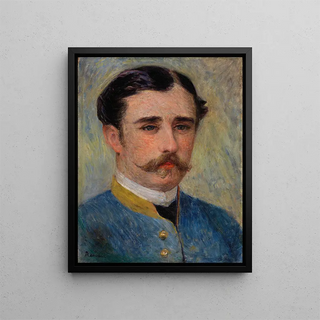Art print | Portrait of a man Monsieur Charpentier - Pierre-Auguste Renoir


View from behind

Frame (optional)
In the rich and vibrant universe of Impressionist painting, certain artworks stand out for their ability to capture the very essence of humanity. The "Portrait of Monsieur Charpentier" by Pierre-Auguste Renoir is a striking example. This painting, depicting an elegant and contemplative man, invites us to delve into the intimacy of his subject while revealing the technical mastery of the artist. Through this art print, we have the opportunity to rediscover not only the beauty of the subject but also the luminous and warm atmosphere that characterizes Renoir's work. This portrait, imbued with charm and delicacy, bears witness to a time when art reflected emotions and human relationships.
Style and uniqueness of the work
The "Portrait of Monsieur Charpentier" stands out for its bold use of color and light. Renoir, faithful to his Impressionist style, favors fluid brushstrokes and delicate nuances that breathe life into his subject. The chosen palette evokes a soft and intimate atmosphere, where each hue contributes to creating visual harmony. The lighting, subtly balanced, highlights the features of Monsieur Charpentier's face while maintaining a certain ambiguity that invites the viewer to ponder his thoughts and emotions. This approach, characteristic of Renoir, transcends the simple portrait to become a true psychological exploration, where the individual is illuminated in all their complexity.
The artist and his influence
Pierre-Auguste Renoir, an emblematic figure of the Impressionist movement, managed to mark his era with his unique vision of painting. By moving away from academic conventions, he paved the way for a new way of perceiving and representing the world. His influence is felt not only in his works but also across generations of artists he inspired. Renoir had this rare ability to seize the present moment, to capture fleeting emotions, and to transcribe them onto the canvas with such intensity that they still resonate today. The "Portrait of Monsieur Charpentier" is not just a simple representation; it is the reflection of a dialogue

Matte finish

View from behind

Frame (optional)
In the rich and vibrant universe of Impressionist painting, certain artworks stand out for their ability to capture the very essence of humanity. The "Portrait of Monsieur Charpentier" by Pierre-Auguste Renoir is a striking example. This painting, depicting an elegant and contemplative man, invites us to delve into the intimacy of his subject while revealing the technical mastery of the artist. Through this art print, we have the opportunity to rediscover not only the beauty of the subject but also the luminous and warm atmosphere that characterizes Renoir's work. This portrait, imbued with charm and delicacy, bears witness to a time when art reflected emotions and human relationships.
Style and uniqueness of the work
The "Portrait of Monsieur Charpentier" stands out for its bold use of color and light. Renoir, faithful to his Impressionist style, favors fluid brushstrokes and delicate nuances that breathe life into his subject. The chosen palette evokes a soft and intimate atmosphere, where each hue contributes to creating visual harmony. The lighting, subtly balanced, highlights the features of Monsieur Charpentier's face while maintaining a certain ambiguity that invites the viewer to ponder his thoughts and emotions. This approach, characteristic of Renoir, transcends the simple portrait to become a true psychological exploration, where the individual is illuminated in all their complexity.
The artist and his influence
Pierre-Auguste Renoir, an emblematic figure of the Impressionist movement, managed to mark his era with his unique vision of painting. By moving away from academic conventions, he paved the way for a new way of perceiving and representing the world. His influence is felt not only in his works but also across generations of artists he inspired. Renoir had this rare ability to seize the present moment, to capture fleeting emotions, and to transcribe them onto the canvas with such intensity that they still resonate today. The "Portrait of Monsieur Charpentier" is not just a simple representation; it is the reflection of a dialogue






